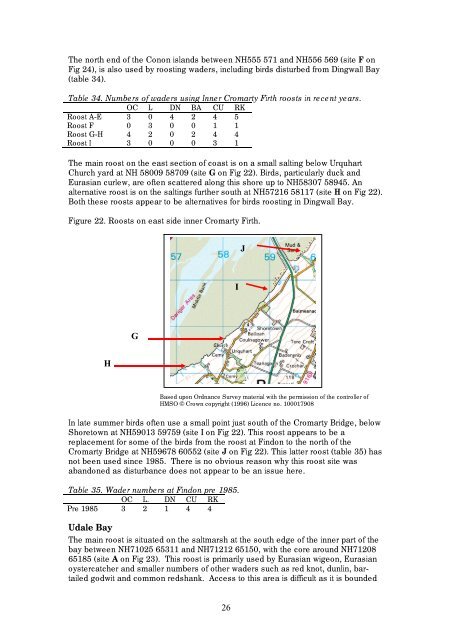Commissioned Report 252 - Scottish Natural Heritage
Commissioned Report 252 - Scottish Natural Heritage
Commissioned Report 252 - Scottish Natural Heritage
You also want an ePaper? Increase the reach of your titles
YUMPU automatically turns print PDFs into web optimized ePapers that Google loves.
The north end of the Conon islands between NH555 571 and NH556 569 (site F on<br />
Fig 24), is also used by roosting waders, including birds disturbed from Dingwall Bay<br />
(table 34).<br />
Table 34. Numbers of waders using Inner Cromarty Firth roosts in recent years.<br />
OC L DN BA CU RK<br />
Roost A-E 3 0 4 2 4 5<br />
Roost F 0 3 0 0 1 1<br />
Roost G-H 4 2 0 2 4 4<br />
Roost I 3 0 0 0 3 1<br />
The main roost on the east section of coast is on a small salting below Urquhart<br />
Church yard at NH 58009 58709 (site G on Fig 22). Birds, particularly duck and<br />
Eurasian curlew, are often scattered along this shore up to NH58307 58945. An<br />
alternative roost is on the saltings further south at NH57216 58117 (site H on Fig 22).<br />
Both these roosts appear to be alternatives for birds roosting in Dingwall Bay.<br />
Figure 22. Roosts on east side inner Cromarty Firth.<br />
H<br />
G<br />
Based upon Ordnance Survey material with the permission of the controller of<br />
HMSO © Crown copyright (1996) Licence no. 100017908<br />
In late summer birds often use a small point just south of the Cromarty Bridge, below<br />
Shoretown at NH59013 59759 (site I on Fig 22). This roost appears to be a<br />
replacement for some of the birds from the roost at Findon to the north of the<br />
Cromarty Bridge at NH59678 60552 (site J on Fig 22). This latter roost (table 35) has<br />
not been used since 1985. There is no obvious reason why this roost site was<br />
abandoned as disturbance does not appear to be an issue here.<br />
Table 35. Wader numbers at Findon pre 1985.<br />
OC L. DN CU RK<br />
Pre 1985 3 2 1 4 4<br />
Udale Bay<br />
The main roost is situated on the saltmarsh at the south edge of the inner part of the<br />
bay between NH71025 65311 and NH71212 65150, with the core around NH71208<br />
65185 (site A on Fig 23). This roost is primarily used by Eurasian wigeon, Eurasian<br />
oystercatcher and smaller numbers of other waders such as red knot, dunlin, bartailed<br />
godwit and common redshank. Access to this area is difficult as it is bounded<br />
26<br />
I<br />
J

















